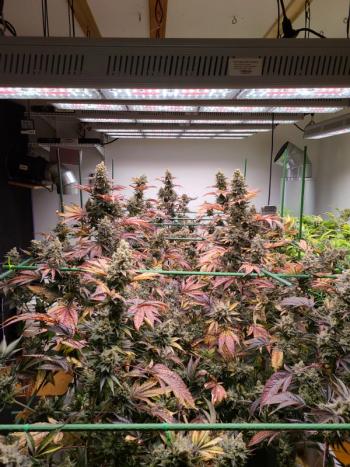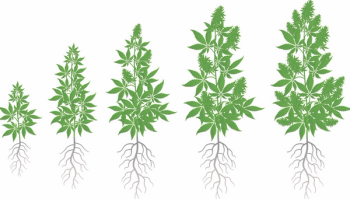
This article examines why we should be studying the cannabinoids beyond THC and CBD in order to explore their potential medical value.

This article examines why we should be studying the cannabinoids beyond THC and CBD in order to explore their potential medical value.

Understanding the biochemical and physical process that comprise and control leaf-level physiology gives us deep insight into the plant, which may convert directly to cultivation practices.

The various extract types are defined so there can be some consensus once and for all.

When a patient isn’t able to access the care or medication that they need in their home country, they aren’t left with much of a choice but to travel to a country that will give them the treatment they need. In part II of this interview series, Nikki Lawley, founder of Nikki and the Plant, LLC, and retired licensed practical nurse (LPN), continues discussing her journey to health, the broken healthcare system hurting medical cannabis patients in the US, and what needs to change to make access better for patients.

Part II of this series reviews the history of vape products, producing cannabis vapes, the myriad of extract types, and how temperature and hardware impact the user experience.

On May 19, 2022 a federal appeals court ruled in a California vaping dispute that delta-8 tetrahydrocannabinol (THC) derived from hemp is “lawful.”

Dr. Woody, chief executive officer of 180 Life Sciences, discusses in this interview the current research surrounding synthetic cannabinoids as a treatment for chronic pain, as well as the development of a new type of medication that would have the potential to offer the benefits of cannabis without any undesirable effects.

The science of cannabis is in its beginning stages and has a large opportunity for growth advancement. Market Manager for Cannabis for Shimadzu, Eberhardt Kuhn, Ph.D., will be presenting two talks for both the hemp and analytical tracks, “Starting with the Roots - the Many Uses of Hemp” and “Delta Dawn - the Next Generation of Cannabinoids?” If you are interested in exploring hemp or cannabidiol (CBD) and other cannabinoids, check out both of these presentations to learn more! In this interview, Kuhn also discusses his interests in the cannabis industry and other presenters at the Cannabis Science Conference (CSC) West taking place in Long Beach, California from May 18–20, 2022.

In part one of this two-part series, we review the history of vape products and their obstacles.

Cannabis Science Conference West, taking place May 18-20 in Long Beach, California, is quickly approaching. The two-day agenda is packed with exciting speakers from around the country as well as many prominent women moving the industry forward. In honor of Women’s History Month, we connected with Dr. Lakisha Jenkins-Samuels, a traditional naturopath, Dr. Lakisha™️.

As time passes and more research comes to light regarding COVID-19, additional research is also needed for cannabis and its various cannabinoids. Through new data, cannabis has shown that it has more to offer than the stigma it has been clouded by. In this interview, Inesa Ponomariovaite, founder of Nesas Hemp and a holistic health coach, discusses the untapped medicinal properties of cannabidiolic acid (CBDA) and cannabigerolic acid (CGBA) for COVID-19 prevention and treatment and why CBDA is the top cannabinoid.

The new processed cannabis products continue to attract consumers—but black market influence causes hesitancy.

Dr. Richard van Breemen from the Department of Pharmaceutical Sciences in the Oregon State University College of Pharmacy discusses his COVID-19 and cannabis research.

This study focuses on a step-by-step optimization of commercial scale preparative HPLC purification of cannabinoids, specifically cannabidiol, starting with stationary reversed-phase screening, followed by method optimization.

It is demonstrated in this paper that cell viability can be used to determine dose and response effects that are important in understanding toxicities and to detect differences in similar hemp products.

Terpenes can be tricky. Although cannabis is heavily regulated, since cannabis-derived terpenes do not contain tetrahydrocannabinol (THC) and other cannabinoids, they are not regulated in the same way that cannabis is.

In this piece, we touch on the benefits and challenges associated with autoflowering genetics, and provide justification for why these unique varietals may be the catalyst for making cannabis medicine more accessible and approachable for the general population.

Gb Sciences, recently announced positive results from a study of its cannabinoid-containing mixtures as a potential treatment for cytokine release syndrome (CRS). With the high rate of transmission of the Omicron variant in multiple countries, Gb Sciences team are working to move quickly through the development stages for this novel CRS therapy.

Dr. Denise Vidot shares some of her research findings that examine the impact of phytocannabinoids on multiple diseases.

Here we take an in-depth exploration of the structure, function, and variation of cannabinoid receptor 1 (CB1R).

This technical piece is focused on the separation of the individual enantiomers of each compound mentioned above, as well as the combined separation of the compounds from each other for a fast, reliable quantification.

Professor Edvinas Orentas clears the air surrounding the stigma of synthetic cannabinoids.

The 5-part program will dive deep into cultivation, extraction, processing, testing, third-party certifications, and more.

Soil, water, and nutrient compositions play important roles in one’s quest to produce ultrapremium flower material; but unequivocally, it is lighting spectrum, coverage, and penetration that have the most influence over the terminal outcome, particularly in controlled environment agriculture.

This article explores what we do and don’t know about the origins of Cannabis ssp. from a botanical perspective and outlines some of the hypotheses proposed to explain the “why” of cannabinoid production in plants and the approaches that researchers are taking to try and answer this elusive question.